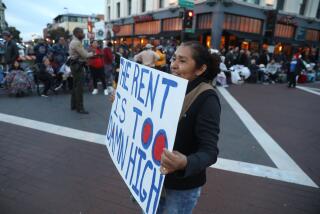A helping hand or cold shoulder for the middle class?
How’s the U.S. economy doing?
If you’re rich, the answer is “fabulously.”
Here are some data points from Diane Swonk, chief economist for Mesirow Financial in Chicago. “Spending at luxury retailers has come back,” she told the Senate Finance Committee last week. High-end merchants routinely “sell out of purses with price tags in the thousands of dollars, before they even hit the shelves in New York. Spending at high-end restaurants is picking up.... Demand is on the rise for boutique hotels catering to the demands of the wealthiest clientele.”
If you’re not rich, things aren’t so fabulous. Spending at grocery stores is down, Swonk reported; even upscale supermarket chain Whole Foods is offering more discounts. Spending at mid-level family restaurants is being “squeezed,” some of them replacing wait staff with tablets from which customers can place their orders directly. Home builders “have almost abandoned building homes for first-time buyers and moved upscale to attract all-cash buyers.”
As we move into budget season in Washington, these are the conditions that demand to be addressed through fiscal policy. Frighteningly, almost no one is taking heed.
There is no denying that the U.S. economy has become more bifurcated over the last few decades. The trend eased a bit during the Great Recession, when Americans at all economic levels saw their wealth decline, but it has picked up again — with a vengeance. Emmanuel Saez of UC Berkeley, who has the go-to numbers on this, says the top 1% captured 95% of all economic growth in the post-recession recovery through 2012.
The squeeze is really felt by the middle class and working class. As Leonard E. Burman, director of the Urban Institute-Brookings Institution Tax Policy Center, told the Senate committee, this group “has suffered from stagnant incomes for more than a generation and the trend shows no sign of abating.” That’s despite the help that middle-income families receive through progressive taxation and other tax-based assistance, such as the earned income tax credit.
On the other side of the coin, however, are tax provisions that heighten income inequality, such as a huge tax break for takeover speculators (the “carried interest” loophole), which he says have “contributed to downward pressure on wages and have cost many workers their jobs.”
The tax breaks for middle-class savings, such as through 401(k)s, aren’t sufficient to encourage saving on the scale needed to protect against income shocks from job loss, much less for college or retirement.
One would love to see these issues addressed in the dueling budget proposals coming from the White House, the Republican-led House and the Democratic-controlled Senate. Dream on.
President Obama’s budget plan, released this month, incorporates job-spurring programs such as infrastructure spending, working-class tax relief via an expanded earned income credit and an expanded preschool program to cover all 4-year-olds from low- and moderate-income families.
But many aspects of the budget look like lip service on a higher plane. It’s still constrained by the quasi-austerity rhetoric that has blocked aggressive recovery programs since 2009, with its references to “our nation’s long-term fiscal challenges” and the need to bring down the debt and deficit.
The best tool for reducing the deficit and bringing down the debt? Economic growth. And in the current slack economy that means aggressive government spending until growth takes hold.
Contrast the White House budget with the proposal released last week by the Congressional Progressive Caucus, all of 84 members strong. Its budget would reverse all cuts imposed by the 2011 sequester agreement, which have fallen heavily on the working and middle classes and sapped economic growth, according to the Congressional Budget Office. It would restore food stamp cuts imposed by Congress in two actions late last year and this year. It would extend unemployment benefits for the long-term unemployed.
On taxes, which are largely untouched by the Obama budget, the progressive caucus would restore Clinton-era marginal tax rates on those earning more than $250,000. (When Clinton left office in 2001, couples earning the inflation-adjusted equivalent of today’s $250,000 paid 36%. The tax rate jumped to 39.6% for those earning more than $384,000. Today their statutory tax rate is 33% on incomes of $250,000 to $390,000, 35% from that level to $440,000 and 39.6% above that. The progressives would add a surcharge of several percentage points on incomes $1 million and higher.
The House Budget Committee hasn’t yet released its new plan, but the previous proposals issued by the committee chair, Paul Ryan (R-Wis.), don’t leave much hope for targeted working- and middle-class relief. Last year’s version leaned heavily toward spending cuts aimed at addressing “the debt crisis ahead” — never mind the jobs crisis today. That plan would have cut taxes, reducing the top rate to 25%; frozen Pell grants, which aid students in higher education; effectively cut food stamps; repealed premium subsidies provided by the Affordable Care Act and taken aim at Medicare and Social Security.
Ryan has been speaking out lately about the crisis of poverty in the U.S., but his attentiveness to this enduring issue is curious, and a little suspect. That’s because under the circumstances it sounds, oddly enough, like a distraction. Poverty is an extreme form of economic inequality, but it attracts purveyors of sociological nostrums more than does the economic plight of the working class.
Ryan’s dialogue last week with conservative former Education Secretary Bill Bennett on Bennett’s radio show brimmed with sociological speculation. Ryan talked about the “dignity of work,” about the “tailspin of culture in our inner-cities ... of generations of men not even thinking about working.”
“If you’re driving from the suburb to the sports arena downtown by these blighted neighborhoods, you can’t just say, ‘I’m paying my taxes, government’s going to fix that,’” Ryan said. “You need to get involved yourself, whether it’s through a mentor program or some religious charity, whatever it is, to make a difference. And that’s how we help resuscitate our culture.”
Leaving aside the evident racial dog-whistle of the term “inner city” — Ryan says he didn’t mean to make a racial comparison and was merely “inarticulate.” The reason we listen to him is that he’s a highly placed government official, not a pastor.
Community service and religious good works should be encouraged and celebrated, but Ryan’s job is to figure out how to apply government resources to a problem that is self-evidently a government concern. Implying that mentoring or charitable good works can substitute for a government obligation is an abdication of his responsibility.
Government, in short, has been missing in action when it comes to the plight of the vast economic middle. What little has been done has bypassed Congress altogether. That includes President Obama’s executive order raising the minimum wage on federal contracts to $10.10 an hour, a level that should be in effect throughout the private sector and is too low even at that.
Last week, he issued another executive order directing the Labor Department to tighten its regulations on overtime, which are commonly flouted by employers. The current rules prohibit employers from defining as “supervisors” — and thus depriving of time-and-a-half overtime pay — anyone earning less than $455 a week. Overtime is typically for work exceeding 40 hours a week. That income level is less than the poverty line for a family of four. (In California, employers must pay overtime to anyone earning less than $640 a week.)
In Congress, Democratic and Republican senators were patting themselves on the back last week for negotiating a deal to extend long-term emergency unemployment benefits for five months; it’s more than likely that even that cheeseparing deal will be rejected by the House.
The more dramatic proposals from the progressive caucus are dismissed as pipe dreams. Improving access to higher education for working-class children, which is the best path to the middle class and better? Everyone in Washington will nod in agreement that it’s necessary, and no one will lift a finger to achieve it.
So let’s keep this rhetoric about helping the middle class in perspective. It isn’t happening. The proof is in the numbers.
As Swonk told the Senate Finance Committee, “those who have their incomes and fortunes tied to financial market gains” will do well in this economy. But that’s “an extremely small percentage of households.” As for the rest, she said, “this tide we call a subpar recovery is still unlikely to lift all boats.”
Michael Hiltzik’s column appears Sundays and Wednesdays. Read his blog, the Economy Hub, at latimes.com/business/hiltzik, reach him at mhiltzik@latimes.com, check out facebook.com/hiltzik and follow @hiltzikm on Twitter.







